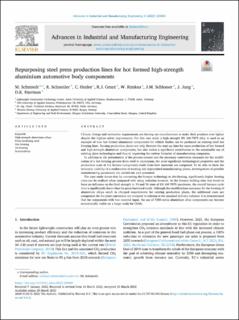| dc.contributor.author | Schmiedt, M. | |
| dc.contributor.author | Schneider, R. | |
| dc.contributor.author | Hezler, C. | |
| dc.contributor.author | Grant, Richard John | |
| dc.contributor.author | Rimkus, W. | |
| dc.contributor.author | Schlosser, J.M. | |
| dc.contributor.author | Jung, J. | |
| dc.contributor.author | Harrison, D.K. | |
| dc.date.accessioned | 2023-03-21T14:51:37Z | |
| dc.date.available | 2023-03-21T14:51:37Z | |
| dc.date.created | 2022-05-30T10:55:45Z | |
| dc.date.issued | 2022 | |
| dc.identifier.citation | Advances in Industrial and Manufacturing Engineering. 2022, 4 . | en_US |
| dc.identifier.uri | https://hdl.handle.net/11250/3059589 | |
| dc.description.abstract | Climate change and normative requirements are forcing car manufacturers to make their products ever lighter despite the highest safety requirements. For this case study a high-strength EN AW-7075 alloy is used as an example of how hot formed aluminium components for vehicle bodies can be produced on existing steel hot forming lines. Reusing production plants not only shortens the start-up time for mass production of hot formed and high-strength aluminium components, but also makes a significant contribution to the sustainable use of existing plant technologies and thus to improving the carbon footprint of manufacturing companies.
In addition to the presentation of the process control and the necessary conversion measures for the modification of a hot forming process from steel to aluminium, the most significant technological properties and the production costs of hot formed components made from both materials are compared. To be able to show the economic viability of a reallocation of existing and depreciated manufacturing plants, investigations of possible manufacturing parameters are carried out and presented.
The case study shows that by converting the furnace technology to Jet-Heating, significantly higher heating rates can be realised when compared with using radiation furnaces. As the furnace holding time was found to have no influence on the final strength in T4 and T6 state of EN AW-7075 specimens, the overall furnace cycle time is significantly lower than for press-hardened steels. Although the modifications necessary for the forming of aluminium alloys result in changed requirements for existing production plants, the additional costs per component for the plant conversion are marginal in relation to the assumed delivery volumes. It is demonstrated that for components with low material input, the use of 7000 series aluminium alloy components can become economically viable on a larger scale for OEMs. | en_US |
| dc.language.iso | eng | en_US |
| dc.rights | Attribution-NonCommercial-NoDerivatives 4.0 Internasjonal | * |
| dc.rights.uri | http://creativecommons.org/licenses/by-nc-nd/4.0/deed.no | * |
| dc.title | Repurposing steel press production lines for hot formed high-strength aluminium automotive body components | en_US |
| dc.type | Peer reviewed | en_US |
| dc.type | Journal article | en_US |
| dc.description.version | publishedVersion | en_US |
| dc.rights.holder | © 2022 The Authors | en_US |
| dc.source.volume | 4 | en_US |
| dc.source.journal | Advances in Industrial and Manufacturing Engineering | en_US |
| dc.identifier.doi | 10.1016/j.aime.2022.100080 | |
| dc.identifier.cristin | 2028041 | |
| dc.source.articlenumber | 100080 | en_US |
| cristin.ispublished | true | |
| cristin.fulltext | original | |
| cristin.qualitycode | 1 | |

